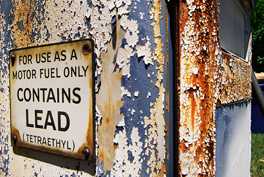LEAD

Information for Workers
How You Can Keep Yourself and Your Family Safe from Lead
- Eat and/or drink in areas where lead-containing products are not being handled or processed.
- Use an effective lead removal product to clean your hands. Washing skin with standard soap and water is not enough to remove lead residues. 1 Full Disclosure® hand wipe technology lets you know instantly if they have lead on your hands. It was licensed in 2003 and is commercially available from SKC, Inc. Hygenall Decontamination Towels are also available, which remove 98% of lead residues from skin. Mention of a company name does not imply commercial endorsement by NIOSH.
- Shower and change your clothes and shoes after working around lead-based products. This will keep lead dust from being tracked through your home, which will lower the chance of your family being exposed.
- Work in areas that are well-ventilated.
- Wear the proper personal protective equipment (PPE), such as goggles, gloves, boots, and protective clothing, to prevent contact while working around lead and lead dust. In some cases a respirator may be necessary. Talk with a health and safety or union representative from your worksite or call 800-CDC-INFO (800-232-4636) to learn more.
- Talk with your doctor about workplace lead exposure if you are pregnant or planning to become pregnant. The Occupational Safety and Health Administration (OSHA) Lead Standard states that "the physician may recommend special protective measures or medical removal for an employee who is pregnant or who is planning to conceive a child when, in the physician’s judgment, continued exposure to lead at the current job would pose a significant risk." For more information see Appendix C of the OSHA Lead Standard.
- If you are a working mom who is being exposed to lead while still breastfeeding, consult your pediatrician to decide if you should have your blood lead level (BLL) tested.
- Talk with your employer to see if they do routine BLL testing; this is a simple blood test that can measure your blood lead levels. If not, you may talk with your doctor about having this test done. If levels are high, you can take steps to protect yourself and your family better.
- If you are concerned that you are being exposed to lead or another workplace hazard, contact our Health Hazard Evaluation Program and request to have your work environment assessed for free. For more details and to fill out a request, visit the NIOSH Health Hazard Evaluation website.
- Contact the OSHA office nearest you if you are concerned about unsafe working conditions.
- Check out the publications page for more ways to lower job-related lead exposure, and to learn about industry-specific recommendations.
References
1Filon FL, Boeniger M, Maina G, Adami G, Spinelli P, Damian A. [2006]. Skin absorption of inorganic lead (PbO) and the effect of skin cleansers. Journal of Environmental Medicine. [ http://www.ncbi.nlm.nih.gov/pubmed/16832226 ] 48(7): 692-699.
- Page last reviewed: April 19, 2017
- Page last updated: April 19, 2017
- Content source:
- National Institute for Occupational Safety and Health
Division of Surveillance, Hazard Evaluations and Field Studies
- National Institute for Occupational Safety and Health


 ShareCompartir
ShareCompartir